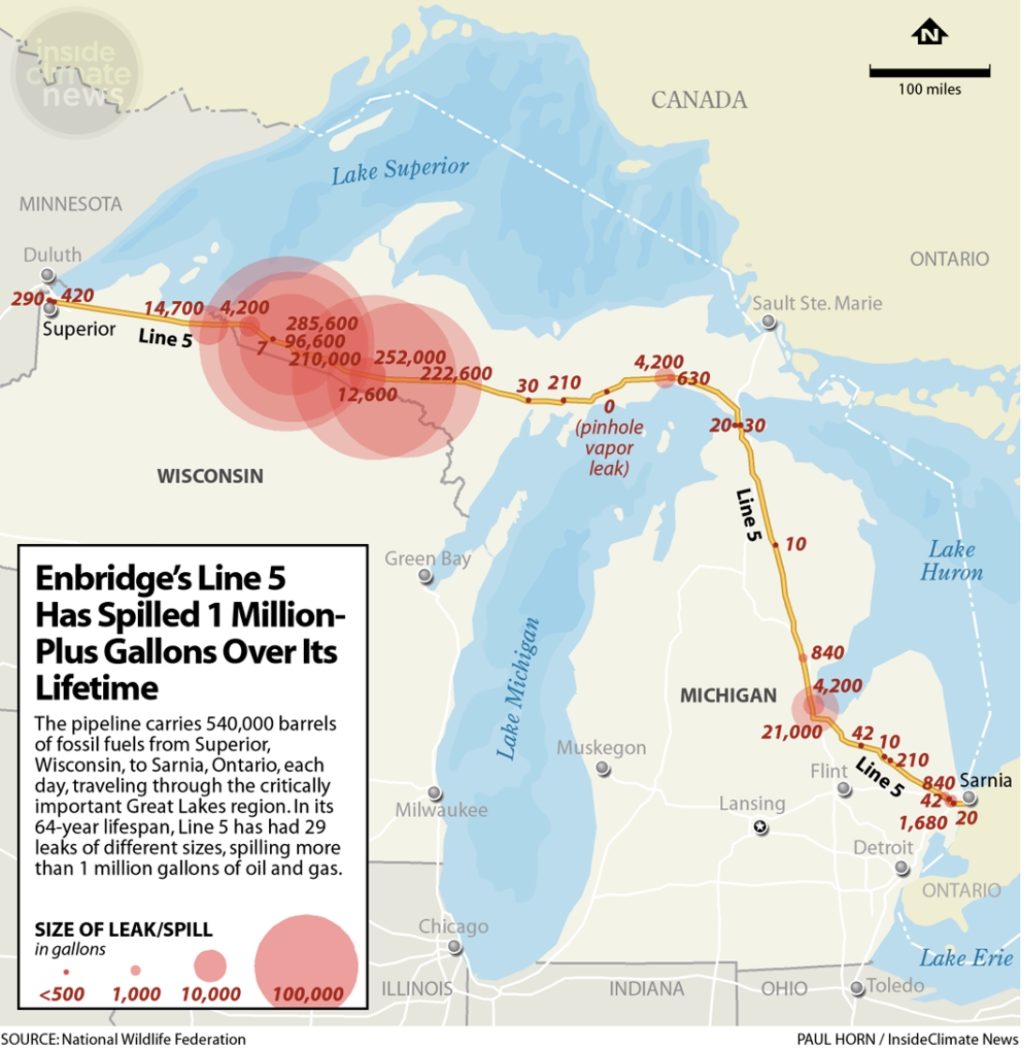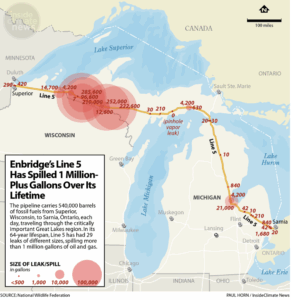A Threat to the Entire Great Lakes Basin: Enbridge Line 5

The Great Lakes, which contain over 20% of the world’s fresh surface water, are not only an ecological treasure but also a vital resource for more than 40 million people in the United States and Canada. Yet this precious ecosystem faces a looming threat: Enbridge’s Line 5.
Constructed in 1953, Line 5 is an aging oil pipeline that cuts through the heart of the Great Lakes basin, transporting crude oil and natural gas liquids from western Canada to eastern markets. Most concerning is the stretch of pipeline that runs directly through the Straits of Mackinac—the narrow, turbulent waters that connect Lake Michigan to Lake Huron. Here, beneath one of the most sensitive and dynamic freshwater systems on Earth, Line 5 poses a danger too great to ignore.
A Pipeline Past Its Prime
At over 70 years old, Line 5 has been operating for more than two decades beyond its intended design life. Like any aging infrastructure, its risk of failure increases with time. Inspections have revealed corrosion, protective coating loss, and structural vulnerabilities. While Enbridge insists the pipeline is safe, independent experts and environmental advocates warn that it’s not a matter of if, but when a catastrophic failure could occur.
Why the Straits Are the Worst Possible Place for a Spill
The Straits of Mackinac are a unique and vital part of the Great Lakes system. The waters here are fast-moving, unpredictable, and capable of carrying oil in both directions—making containment virtually impossible in the event of a spill. According to University of Michigan researchers, a worst-case rupture could contaminate up to 700 miles of shoreline, devastating fisheries, wetlands, and wildlife habitats, and threatening drinking water for millions.
The Economic Toll of Disaster
Beyond ecological devastation, a spill would bring steep economic consequences. The region’s tourism and recreation industries could collapse. Commercial fishing—already under pressure from pollution and invasive species—would suffer irreparable harm. Municipal water systems would face shutdowns, disruptions, and costly cleanups.
A Violation of Indigenous Rights
Line 5 also traverses tribal lands and waters that are protected under long-standing treaties. For many Indigenous communities, the pipeline endangers not just the environment but their cultural identity, food sovereignty, and treaty rights. Multiple Tribes have voiced strong opposition to both the continued operation of Line 5 and Enbridge’s proposed tunnel project, which they see as perpetuating a colonial approach to resource extraction.
Enbridge’s Controversial Tunnel Proposal
In an attempt to secure the pipeline’s future, Enbridge has proposed building a tunnel beneath the Straits to house a replacement section of Line 5. But this plan has drawn widespread criticism. Environmental groups and several Michigan officials argue that the tunnel would lock in fossil fuel infrastructure for decades to come—at a time when we urgently need to transition away from carbon-intensive energy systems.
In May 2025, pressure mounted on Michigan regulators to reject the tunnel proposal amid growing public concern. Critics point to unanswered safety questions, seismic and geologic risks, and Enbridge’s own track record—including the infamous 2010 Kalamazoo River spill, one of the worst inland oil spills in U.S. history.
The Case for Shutting It Down
The clearest path forward is to shut down Line 5. The pipeline is not essential to regional energy security—numerous studies and analyses have identified alternative routes and transportation methods for oil and gas that do not involve crossing the Great Lakes. Transitioning to these alternatives would not only reduce the risk of environmental disaster but also support a broader shift toward clean, sustainable energy.
What’s at Stake
This is more than a regional infrastructure debate. The Line 5 controversy underscores a critical moment in our relationship with the natural world. Will we prioritize short-term fossil fuel profits over the long-term health of one of the most important freshwater systems on the planet? Or will we take the necessary steps to protect the Great Lakes for future generations?
The Time to Act Is Now
We must urge Michigan officials—and federal regulators—to reject the tunnel proposal and decommission Line 5. The risks are too high, and the alternatives are within reach. It is time to put the health of the Great Lakes, the rights of Indigenous nations, and the long-term wellbeing of our communities above corporate interests.
Protect the Great Lakes. Shut down Line 5.
 The Wisconsin Sierra Club writes:
The Wisconsin Sierra Club writes:
Enbridge’s Line 5 pipeline transports 22 million gallons of crude oil and natural gas liquids across 645 miles of countryside every, single day — from Superior, Wisconsin through Michigan’s Upper Peninsula, under the Straits of Mackinac, and down to refineries in Sarnia, Ontario. Originally built in 1953, this aging line — which has long outlived its anticipated lifespan — has significantly deteriorated over the course of the last several decades and poses catastrophic risks to the neighboring farmland, pristine natural areas, valuable freshwater sources (including 400 rivers, streams, and wetlands), and tribal lands that it cuts through.
Alarmingly, Line 5 has a long history of unleashing environmental damage. In the last 50 years, the pipeline has had 29 spills, releasing a total of 1.1 million gallons of toxic oil into the environment. Researchers recently determined that most spills were not even discovered by Enbridge’s leak detection systems, which Enbridge uses to justify reckless pipeline routes. Additionally, parts of the pipeline have begun corroding and cracking, and other parts were recently found to violate Enbridge’s original easement due to improper bracing and a failure to provide adequate structural support.
Thankfully, there haven’t been any spills in the most vulnerable locations — at least not yet. But experts argue that it’s only a matter of time — the company is playing with fire by allowing Line 5 to continue pumping oil through its antiquated infrastructure. Two parts of Line 5 are particularly concerning: a portion that traverses the Bad River Reservation in Wisconsin and another five-mile stretch that runs under the Straits of Mackinac through the Great Lakes. (Read more.)